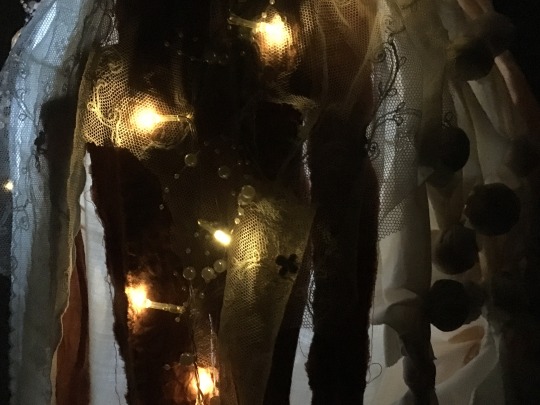Video
youtube
youtube
Same video edited but with different sounds because I’m unsure which is best (do I have music at all?? I think it helps show the movement in conversation with a rhythm). The first video has a heart beat of a foetus and mother whilst the other has a drum beat.
I like the speed of the drumming music, but does it create a context that isn’t appropriate for the work as it makes it seem kind of carnivalesque, however, I do like the associations to something ritualistic, especially combined with the moves of the performers in the shared skin. It seems quite tribal, and at one point we bow so it seems almost sacrificial.
The heartbeat at least gives some background noise, a consistent beat that works in time with the movements. Interpretations of two bodies and mother/ child, family connections can be assumed.
0 notes
Video
vimeo
Katherine Dunham Technique Disc 1 #8 2nd Position Plié w/ Pelvic Contractions
Tried the plies and curvatures of the spine but wasn’t so effective as suit is not wide enough. Will stick to long lines and keeping arms above head or stuck to sides as to not get caught in the tights/ have them ride up during performance.
0 notes
Video
vimeo
The Dance Technique of Lester Horton: An Advanced Beginners Class
I like Horton’s focus on lateral movements and creating clean lines with the body by using the hips like a hinge and flat backs.
0 notes
Photo
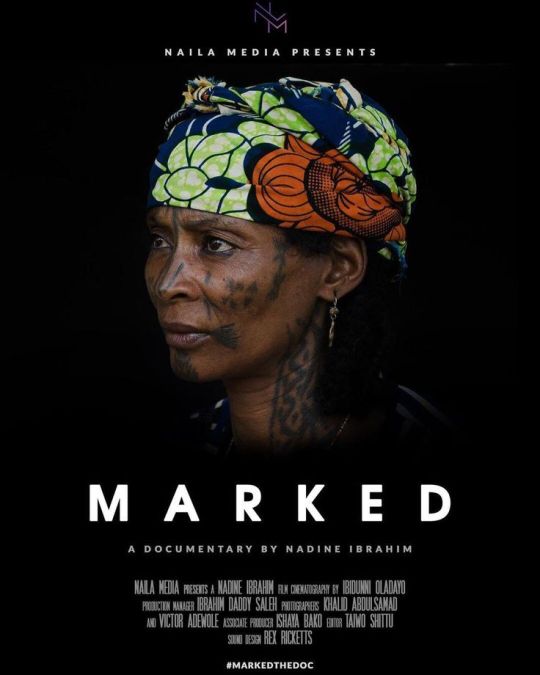
21.04.2021
Shot by Nadine Ibrahim in several cities in Nigeria, 'Marked' explores the reasons behind scarification in Nigeria as well as how the practice intertwines with beauty, identity and spirituality..
I learnt that body modification was practised on those as young as infants or even new-borns in belief that it would ward away sickness and ‘convulsions’ : parallel to western practice of vaccine immunisation.
Many women endured scaring as an act of strength and perseverance, making her more beautiful. In one case, which made me quite uncomfortable, was that young girls in a village would have incisions made on their bodies/faces and the men would tip the girl who showed the least discomfort to what must be very painful. The girl described these girls as the most admired.
Some tribes use markings as way of identification or for spiritual symbolism, ranking within tribe and social status (as has been used in slavery). Marked skin has a heavy history. Almost all the people interviewed were proud of their scars and would feel less like themselves without their unique markings. However, despite this general practice, marked skin seems to clash with social norms (I assume the people interviewed live in the countries they grew up such as Benin and Nigeria had experiences where their markings prevented them from having jobs (either cover them up or leave) or were mocked (though these may have been cases where children are plain mean).
I loved the treatment of the interviewees and how their experiences and thoughts of their skin led the narrative of the film. It was sensitively shot with beautiful portraits of each speaker with their scarring clear on show.
0 notes
Photo
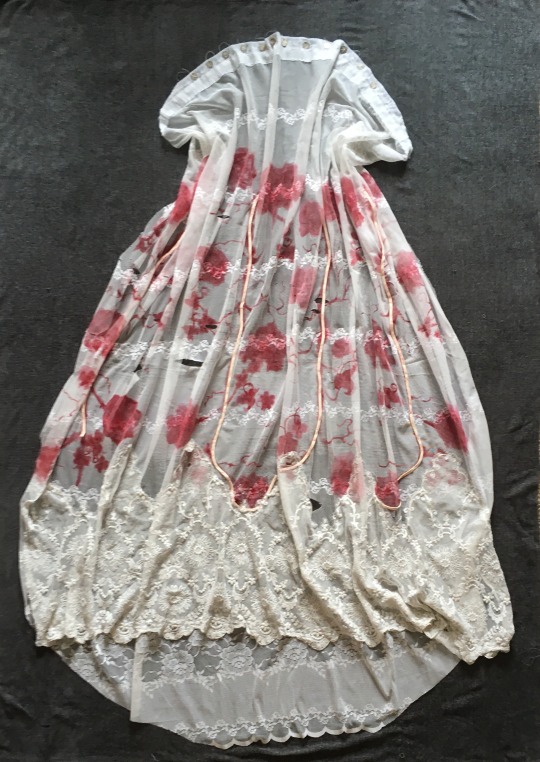
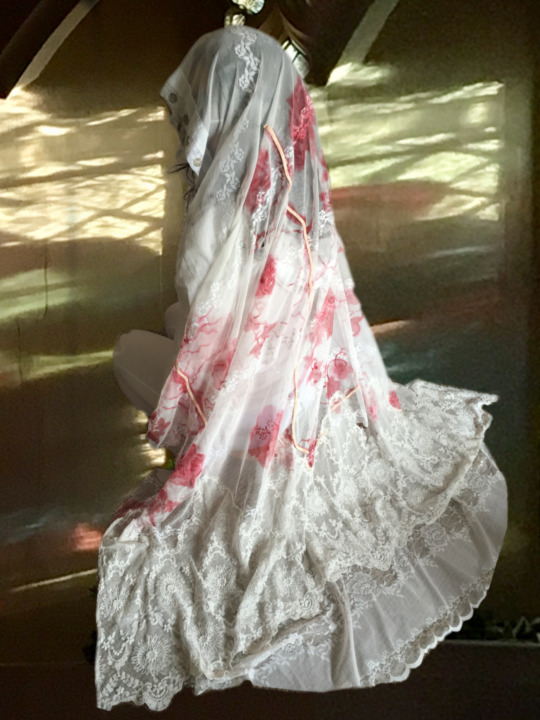
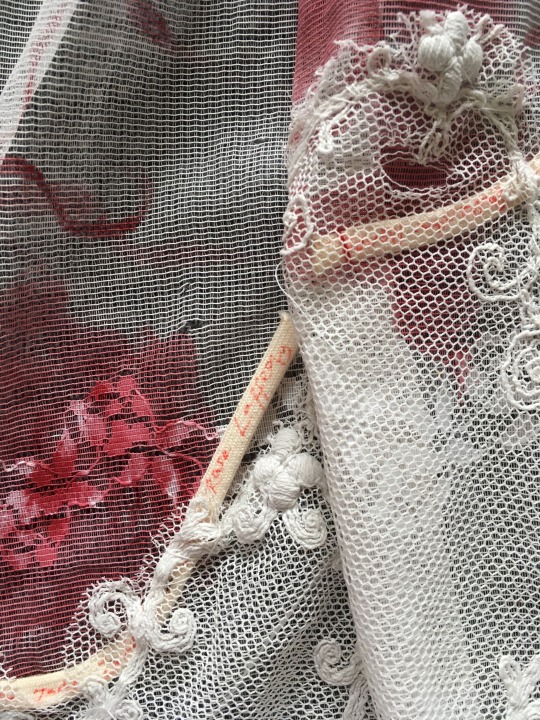
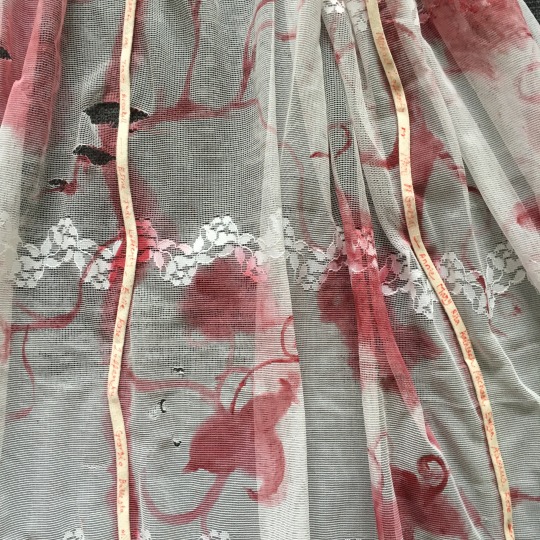
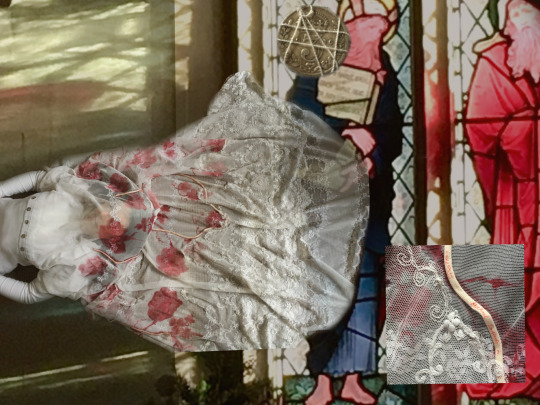
Mantilla
Old lace and net curtaining, acrylic, cotton thread and threepenny bits. Blood lines and names of family have been inscribed along the cotton thread ‘roots’ that span from my abuela’s immediate family, her marriage to my grandfather and her children, to my dad then to me.
Themes of growth: generations and planting oneself in a foreign culture.
Unsure of how to present. Reminds me of a relic, an artefact, so I immediately think it should be on display not handled - almost too fragile. Equally it is a garment, worn by the bride on her wedding, so I thought of collaging some photos I took last year on a walk with my nan. I loved how the stained glass windows filled the church in syrupy light, I also thought it would place the veil in it’s context.
0 notes
Video
youtube
Collaged the videos I took of the sculpture (I imagine this as an installation in real life whereby the viewer is invited to walk, sit and lie around the sculpture as they please).
Includes slowed down underwater sea sound to add to this meditative space.
0 notes
Photo

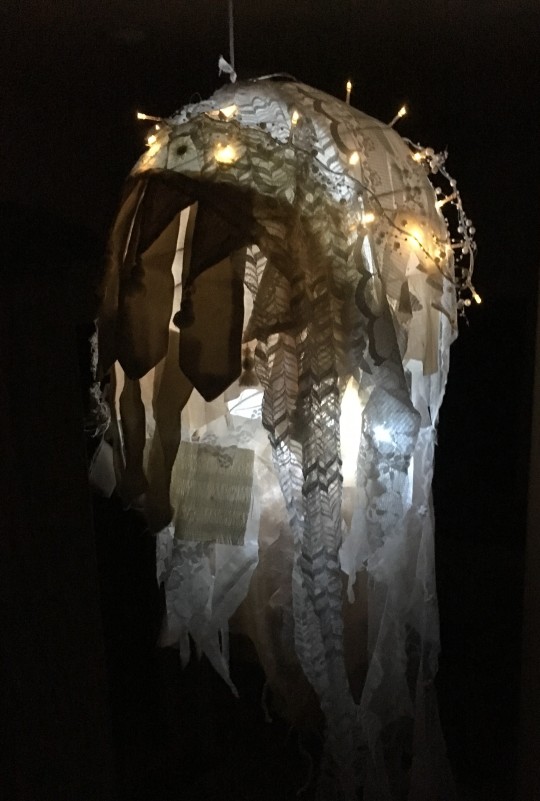

Cephalopod
Tied to banister upstairs, causing the sculpture to twirl slowly from the ribbon holding it up, creating a lovely ghostly, watery feel to the organism. I wasn’t able to capture the shadows it cast on the walls, they were very weak but visible! The lace produced light hazy shadows across the walls and due to the cold lights inside the lampshade it gave a bluish hue to the walls. Underwater/ cool environment. It was rather comforting. My sister and I lay down on the floor just watching the sculpture twirl above us for an age; it was so calming.
0 notes
Photo
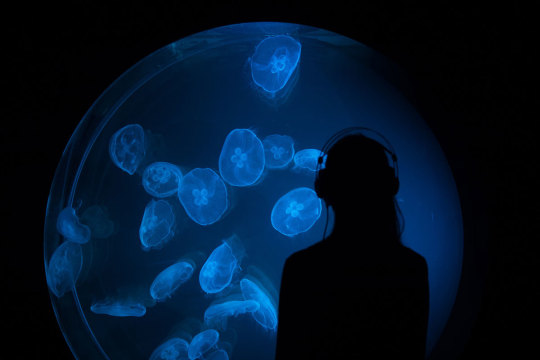
Rimini Protokoll,win > < win.
Installation view, Eco-Visionaries: Confronting a planet in a state of emergency, Royal Academy of Arts, London, 23 November 2019 — 23 February 2020. Photo: © Royal Academy of Arts, London / David Parry.
1 note
·
View note
Text
Group Tutorial - 1/03/21
Group tutorial with Jala discussing bulbous tentacled sculpture. Received lots of useful feedback to help me finalise my outcome as I was struggling what to do with it next. Included photograph in a dark space whilst illuminated from the inside, record/ observe shadows that it casts given different textures I’ve created on surface of sculpture, referencing Cornelia Parker and her exploding fragments of sculptures frozen in mid air. Love how this idea further plays on the viewer’s emotions - their sight has been obscured when put in the dark so senses are more alert to the sounds and drifting shapes they do see when the light catches the fabric on my sculpture, made more acutely aware of their place in relation to the object (if strung up high who has more power? who is predator?prey? and the environment made to exist for the sculpture. Makes it more alive when situated in a specific environment. Reminding me of RA’s eco-visionaries, I was captivated by Rimini Protokoll’s win > < win : an enclosed, intimate space with audio recording about a dystopic earth where jelly fish are the last survivors on a flooded planet, I was captivated by the audio paired with the hypnotic visuals of real floating jellyfish in a slick round tank. The blue lighting, semi-darkness is a mood I’d like to control with my own sculpture in an installation.)
Someone suggested I push the idea of playing with ‘fleshy’ textures by incorporating more visceral materials like meat - how I can stretch it, salt it, play with the grotesque - fats, muscles, tendons ect.
0 notes
Photo
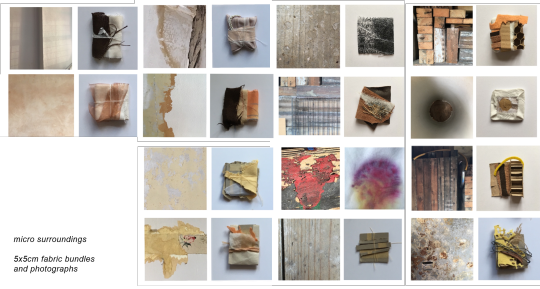
Final collection of fabric squares!
materials: felt, cardboard, hessian, scrap fabric, tissue, thread, leather, cotton, wire, paper, nappy liners, petals, glue.
A few Friday’s ago in an afternoon briefing/ catchup we put up our recent work. I got really good feedback from Ellie and Claire suggesting I build up the amount of squares. I now have a modest collection of 14. Very happy with how they came out and agree the act of laying them out on a blank wall creates its own mini archive under micro surroundings. I organised them on PowerPoint, but would give them even more space to breathe between each other in real life if I had a greater expanse of wall.
0 notes
Video
youtube
Artist talk at uni with Mandy El-Sayegh
Intrigued by her use of language in her paintings. Stealing her father’s arabic notes and letters practiced on the back of old newspapers that date back decades ago! medical language from growing up with a sick parent, her mix of cultures growing up In London, she abstracts all this information to its most ‘literal’ form on large canvases. I find the silk screen prints create a shiny, almost transparent effect on her canvases.
24/02/2021
0 notes
Video
vimeo
Holly Graham
Green Fingers II
video [06:49]
2019
Had an artist talk and seminar with Holly explaining her practice and works in more detail to us. She said she made this filming parts on her iphone and editing them together with the photographs she had shot, playing with the compression of image and layering of videos/ images to switch between the fore and background. I adore the use of snippets of archival material and her own recreations of these (signficantly the Lambeth Archives and photographer Henry Jacobs photos of the Afro-Caribbean community in South London) to create a video collage. It’s like watching the digging at an archaeological site, paired with poetry and language to guide you on a story. I would love to attempt this process with my own material - perhaps my handling of my own fabric pieces, or revisiting the comic I made about my abuela and pair it with footage from the era and dialogue to provide a more nuanced look at that point in her life.
0 notes
Photo



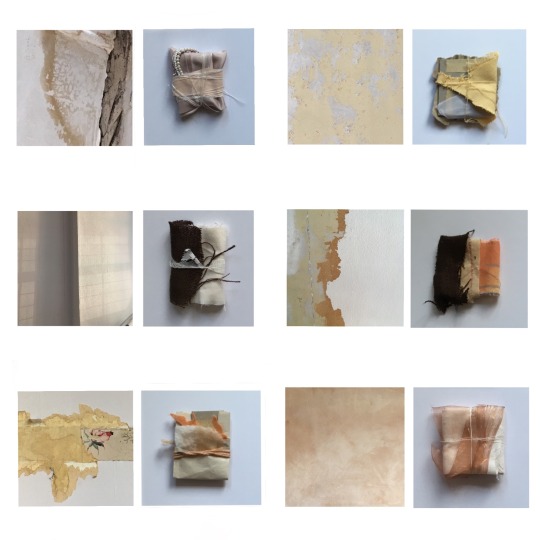

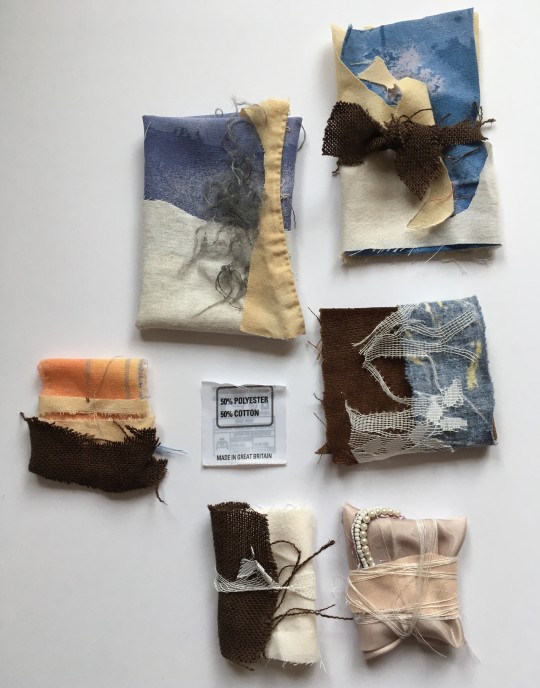
Photographing areas in the house that suggest decay and dilapidation. The size of small tile squares, like painted canvases you’d see painted by abstractionists in art galleries. I was drawn to their textures and interested how they remind me of home, immortalising the ripped nits of wallpaper and bare floorboards into small parcels of scrap fabric that further abstract the colours and shapes that can be seen. I have wrapped the fabric like you would a gift, a present or memory of home that can be passed onto someone else, or like the little samples of lino/ paint swatches you are given at shops like B&Q.
I think I could push this idea further by placing it in that context such as a homewares’ paint swatch catalogue, binding them into a book of keepsake domestic memory.
24/02/2021
0 notes
Photo



Fleshy bulbous sculpture I have been working on, collecting neutral shades and layering lace and scrap fabric together over an old paper lamp shade. Working intuitively and making for the sake of making, I have made an organism reminiscent of jellyfish due to the tentacle like strips of material and blobby surface from scrunched up material.
I think I’ve sub-consciously made a sculpture based with skin and touch in my mind as lockdown has left us craving for this type of love/body language. (I even stumbled across an article about a poor gentleman beginning to talk to chairs during the first lockdown as the nation started to feel the effets of isolation. He’d say he’d get angry at the chairs not replying!) Or perhaps because I’ve been looking into the history of my abuela but have no direct interaction with her - it’s left my imagination and memory of touch to recreate fleshy, skin like textures.
22/02/2021
0 notes
Link
The Spanish word macramé is derived from the Arabic migramah (مقرمة), believed to mean “striped towel”, “ornamental fringe” or “embroidered veil.” After the Moorish conquest, the art was taken to Spain, then to Italy, especially in the region of Liguria, and then spread through Europe. It was introduced into England at the court of Mary II in the late 17th century. Queen Mary taught the art of macramé to her ladies-in-waiting ( Virginia Colton, ed. (1979). Complete Guide to Needlework. p. 445. @ http://www.ancientearthhealing.com/history-of-macrame/) It has since been used by sailors to make hammocks, secure sails and load cargo onto naval boats due to their strength.
1 note
·
View note

